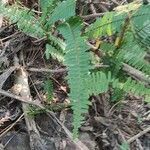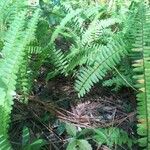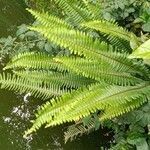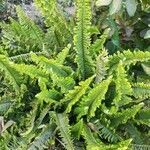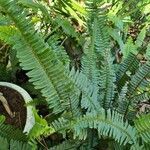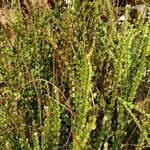Rhizome short, erect to oblique, densely clad in ferruginous ovate-attenuate paleae; emitting slender paleate stolons, sts bearing small "tubers", producing offset plants. Stipites tufted. Stipes 3-10-(15) cm. × 2-3 mm., stout, brown, with attenuate paleae and hairs. Rhachis stout, red-brown, densely to sparsely clad in red-brown paleae and hairs, often ± hidden by basal lobes of pinnae. Lamina linear-lanceolate, dark to rather pale green, membr. to subcoriac., 20-50-(90) × 2-5-(10)cm. Pinnae close-set, very ∞; lower pinnae reduced, us. sterile, increasing to 2 × 1 cm., oblong, obtuse; mid-pinnae, us. fertile, up to 2 cm. × 5 mm., patent, oblong, obtuse, sub-cordately lobed at base; margins ± crenulate; upper pinnae gradually decreasing to acute apex. Veinlets forking at about 1/2 way. Sori about lunulate, dorsal, in 2 rows, discrete, 1-2 mm. at greatest diam., up to 30 per pinna. Indusium firm, about lunulate, covering sori till maturity.
Stolons often producing spherical tubers to 15 mm diam.; stolons, tubers and basal portions of stipes densely covered with linear-lanceolate brown scales with short basal processes and denticulate margins. Fronds to 1 m long (rarely longer); rachis bearing scales consisting of a round dark base giving rise to 1 longer and many shorter hair-like processes. Pinnae usually glabrous, with an enlarged rounded basal auricle overlapping the rachis. Sterile pinnae 12-35 mm long, 6-11 mm wide; margins crenulate towards the rounded apex. Fertile pinnae often shorter, with crenate margins. Sori submarginal, usually in very regular rows with open side of reniform indusium oriented towards pinna apex.
A fern. It can grow in the soil or attached to other plants. It keeps growing from year to year and forms large colonies. It grows about 30-120 cm high. The roots often bear tubers. These can be 1 cm long. The stalk of the fern frond is stiff and brown and often is slightly scaly. It is 10-30 cm long. The fronds are narrow and divided into leaflets along the stalk. The fronds are 30-120 cm long by 2-7 cm wide. The leaflets are many and do not have a leaf stalk. The leaflets are 1-3.5 cm long by 0.4-1 cm wide. There are blunt teeth along the edge. The bases overlap. The spore bodies are kidney shaped. They are close to the leaf edge. It produces fleshy tubers along the runners.
Rhizomes small, erect, densely scaly, producing numerous far-creeping runners; runners scaly and usually bearing fleshy tubers. Stipes 5-25 cm long. Stipes and rachises pale brown, brittle, bearing pale brown hair-like scales. Laminae very narrowly elliptic, 40-100 × (4)-5-8 cm, pinnate, erect. Primary pinnae in > 50 pairs, overlapping in middle of frond, more widely spaced at base, the longest 2-4 × 0.4-1 cm, ± glabrous, oblong or narrowly oblong with a basal acroscopic lobe; apices obtuse; margins markedly crenate or serrate. Sori round, in single rows either side of midrib, protected by crescent-shaped indusia.
Plants terrestrial or epiphytic. Rhizome erect, short, covered with yellowish brown, narrowly lanceolate scales; stolons bearing scaly tubers (1-1.5 cm in diam.). Stipe 5-15 cm, densely covered with same scales as on rhizome; lamina linear-lanceolate or narrowly lanceolate, 25-75 × 3-6 cm, pinnate; pinnae 40-120 pairs, approximate, lanceolate, 1.5-2.5 × 0.6-1.2 cm, unequal at base, margin serrulate to crenate, auricle acute, lower pinnae obtuse, gradually shorter upward; rachis with sparse, fibrillar scales. Sori lunulate or rarely orbicular-reniform; indusia brown, elongate.
